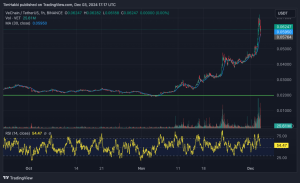Last updated:
 Why Trust Cryptonews
Why Trust Cryptonews
Ad Disclosure
We believe in full transparency with our readers. Some of our content includes affiliate links, and we may earn a commission through these partnerships.

Singapore-based cryptocurrency payment provider DTCpay is set to transition entirely to stablecoins by January 2025, phasing out Bitcoin (BTC) and Ethereum (ETH) transactions by the end of 2024.
Dtcpay’s Shift to Stablecoins: Key Reasons Behind the Transition
According to the company’s announcement, this transition is attributed to the price fluctuations of Bitcoin and Ethereum, which have created challenges for users seeking consistency in digital payments.
The company plans to center its offerings around stablecoins such as USDT (Tether) and USDC (USD Coin), with additional support for FDUSD (First Digital USD) and WUSD (Worldwide USD) in the pipeline.
These stablecoins, pegged to fiat currencies like the U.S. dollar, ensure consistent value, making them a practical alternative for retail and institutional users.
This decision reflects a broader trend in digital payments. In Singapore, stablecoin adoption has surged significantly, with transaction volumes nearly doubling to $1 billion in Q2 2024, according to a Chainalysis report.

The stability of these assets has made them increasingly popular for smaller, everyday transactions that dominate the retail market.
Regulatory advancements in Singapore have further supported this shift.
The Monetary Authority of Singapore (MAS) introduced a framework in late 2023 to enhance the stability of single-currency stablecoins, particularly those pegged to the Singapore dollar or other G10 currencies.
These developments create a conducive environment for stablecoin adoption.
Driving Stablecoin Adoption in Singapore’s Payment Ecosystem
Dtcpay’s pivot to stablecoins aligns with its vision to improve scalability and interoperability in payment services.
As part of this transition, the company plans to integrate FDUSD, which operates on Ethereum and Binance-backed BNB Chain, and WUSD, pegged to the U.S. dollar.
This shift comes after securing a payment institution license from MAS in 2022 and forming partnerships with major entities like Pontiac Land.
The stablecoin trend isn’t limited to Singapore alone. Globally, their adoption is on the rise, especially in banking sectors across Asia, the Middle East, and Europe.
Complementing this, OKX has launched instant deposits and withdrawals in Singapore dollars.
Meanwhile, the Singapore Gulf Bank plans to raise $50 million to acquire a stablecoin payments company, signaling stablecoins’ growing prominence in Singapore’s financial landscape.



















